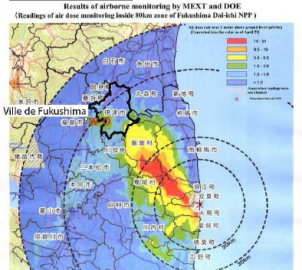
By Marta Conde.
CRIIRAD, a partner of EJOLT, has been working with a local EJO (Environmental Justice Organisation) in Fukushima since the Fukushima Daiichi nuclear disaster occurred in March 11th 2011. More than a year after the disaster, a lot of people in Fukushima prefecture and in other areas of Japan are still exposed to an annual dose of radioactivity in excess of 1 mSv/year (the accepted dose rate by the International Commission on Radiological Protection, ICRP).
CRIIRAD has carried out two missions to Fukushima to give support to the local EJO Citizens Radioactivity Monitor Station (CRMS) and to carry out radioactivity measurements. In the city of Fukushima, located 60-65 km away from the nuclear plant, the dose rates measured at 1 meter above ground in the outside, were typically 3 to 10 times above normal.
CRIIRAD also visited a family in the Oguni area, supposedly decontaminated. They calculated that, for this family, the cumulated external irradiation due to the Fukushima fallout will be between 1.8 and 6 mSv during the year 2012 (even after decontamination). CRIIRAD and CRMS denounced that the decontamination process was insufficient and that people should be given compensation for being able to evacuate to non contaminated territories.
The priority now for the Environmental Justice (EJ) Alliance is to obtain a national strategy for supporting the people affected by the contamination (compensation, support for relocation, etc.). In this context, in June 2012 a new law was passed introducing the concept of “Target support areas” where the inhabitants should receive support for either evacuation, staying there or coming back. One of the main issues that still remains unclear and the EJ alliance is trying to tackle is that of the annual dose above which a territory will be classified as “ Target support area”.
This clarification should be included by January 2013. International pressure is welcome. Follow the link below for additional information.
In 2011, hundreds of thousands of people already received doses far above “acceptable” limits. During 2012, many citizens are still accumulating doses in excess of 1 mSv. This is increasing the risk of various pathologies (including cancer) in the long term. As the risk is cumulative with the dose, everything should be done to enable people to move to non contaminated territories.
More on http://www.criirad.org/actualites/dossier2012/fukushima/5dec2012.html
The CRIIRAD report is here
A video from CRIIRAS doing measurement in Fukushima is here
Other blogs and resources on nuclear energy developed in EJOLT are here



We strongly recommended to protect people against this kind of problems